| |

|
| |
The
White Stork
|
The return of a
splendid bird.
|
Situation
of White Stork nesting in Italy.
|
| |
Text
and photos by Ernesto Francini
|
| |
|
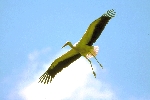
|
White
stork (Ciconia ciconia).
|
| |
|
| In
the collective imaginary of the humanity history
it is considered bearer of good auspice and
symbol of fertility but his kind, considered
extinct on our national territory starting from
the year 1700, has been object in the past of a
heavy persecution from the man, sometimes also to
food purpose. Now, although
slowly, it is returning. As the Spoonbill (platalea
leucorodia) and others splendid birds, as the
Great white egret (egretta alba) the white and
black stork return to nest in our country.
New laws (Italian
law 157/92 and European community directive 79/409/CEE)
assure them the right to existence and they do
them a kind particularly protected.
The better
environmental conditions, the new oasis, the
better care of the territory from our part, has
created such a biodiversity to make now more
desirable the permanence to this animal on our
agricultural grounds for the reproduction and
breeding of his chicks.
Unmistakable for his
big dimensions, standing it has a height superior
to the meter and a wings opening that overcomes 1.5
meter. The long neck and the long legs confer to
the white stork a splendid and superb aspect.
|
| |
|
|
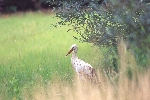 |
|
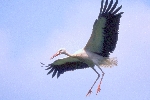
|
| White
stork (Ciconia ciconia). |
|
White
stork in glide (Ciconia ciconia).
|
| |
|
|
|
| The
stork is a carnivorous animal. The bill, long 15-20
cm, of red orange color as the legs,it is strong
and pointed, particularly suited for the hunting
of small preys (bugs, small mammals, amphibians,
reptiles) that hunting in the high grass as in
the water. Males and
female are practically indistinguishable even the
first is generally more big.The young storks are
recognizable for the darkest color of bills and
legs.
This splendid bird
has a spectacular flight that begins with a long
running and a strong wings beat up to the
attainment of the high altitudes.Using correctly
the warm air draughts, it directs therefore his
flight with the least waste of energy.
A flight that
fascinates me and it takes me to such manner that
sometimes I remain to wait for hours and hours
hoping to see it, and when finally, at the
horizon, as a small point appears this splendid
bird I remain pervaded by a thin quiver that
remains in me the whole time that I remain to
observe it.
The big wings, from
which stand out the black remiges in clear
contrast with the other feathers, of candid white
color, have the extremity points frayed similar
to those of the big birds of prey and they allow
the stork to be a good glider.
|
| |
|
|
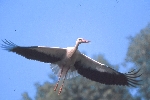
|
|
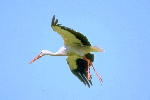
|
White
stork in take-off (Ciconia ciconia).
|
|
White
stork in landing (Ciconia ciconia).
|
| |
|
|
|
| Usually
winters in Africa, to south of the Sahara, and
then it is directed toward Europe to pass the
summer and to nest. The
principal routs of migration are two: the first
passes for the straits of Gibraltar and another
for the Bosphorus. Some storks also transit on
our peninsula, through straits of Messina, but
this rout is not their favorite one because of
the ample part of sea that separates Sicily from
Africa, since the warm air draughts, having
produced from the heating of the ground by the
solar rays, are practically absent above the sea
and therefore make more exhausting the flight.
|
| |
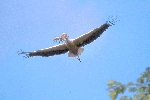
|
White
stork (Ciconia ciconia) that carrying in
the bill material for nest construction.
|
| |
|
| In
past, beginning from the years 1950, some
spontaneous attempts to return to nesting have
been observed in our country but, either for the
not good conditions of territory,
pollution,indiscriminate use drugs in
agriculture, and for the intervention of the man,
which continued to hunting them, they didn't have
had positive result. Only
beginning from 1985, after years devoted to the
environmental reconstruction, to the educational
campaign developed by LIPU (Italian BirdLife) and
WWF, and finally to the approval of a competent
legislation, we have been able to assist to a
slow constant increase of the nesting population,
especially in the north Italian westerner area.
At the present the
wild couples of white stork nesting firmly in our
country are more than 100.
The nest is a very
voluminous base constituted by an interlacement
of dry sprigs of variable dimensions, joined to
straw, leaves and material of other kind.
|
| |

|
| White
stork nest with chicks (Ciconia ciconia). |
| |
|
| It
is generally built in tall position on bell
tower, towers, chimney tops, pylons of the
electric lines, trees, roofs. Although there are
cases in which it is also built to ground level,
in proximities of ponds or sheets of water rich
of the typical alimentary sources necessary for
its nourishment. The nest
construction is made in particular by the female,
although the male provides and collaborates in
the material transport; the job is conducted
quickly in the first two weeks when they come
back from wintering districts.
The stork is
extremely territorial, it defends its own nest
and the neighboring territory from the other
storks and birds.
Violent clashes can
be observed between males and pairs that want to
occupy the same nest.
If there are not
external factors for which it cannot set remedy,
for instance the intervention of the man or the
change of the surrounding environment, the stork
returns to the same nest for a lot of years in
continuation.
I remember a pairs
of storks that every spring returned in the same
nest placed in open country on a pylon of the
electricity and every year, after the
reproduction and breeding of its chicks, they
left it for Africa.The construction of a small
asphalted road, that crossed the field, the
trouble produced by the industrial machineries
used to the purpose, the continuous presence of
the workers provoked the definitive renouncing of
it.
The eggs are of
white color and their weight are about 100g . The
deposed number is middly 4 but they can vary from
1 to 7.Their opening happens after around one
month and both the parents taken care of the
chicks.
The feeding happens
through the regurgitation of the food in the
nest, in precedence ingested by their parents.
If there is the
presence of chicks the defense of the nest
becomes even more bloody.
In a nest built to
ground level, to the edges of a small pond, 3
chicks of stork were attended by their father,
while the female was being to search food in the
proximities.
A Grey heron,
hungry, wandered in the pond, hoping to find
something to eat.I have assisted to the violent
and sudden attack of the male of stork that
struck repeatedly with the bill the heron, when
this, have approached unintentionally, to 1 meter
about from the nest.
|
| |

|
White
stork attack (Ciconia ciconia) against
grey heron (Ardea cinerea).
|
| |
|
| After
about 40-50 days from the birth the chicks begin
to beat the wings to learn to fly and after 2
months of life are already able to abandon the
nest.They life is in average 26 years. The stork is practically
without voice.The adults don't utter sounds to
exception of a weak hiss.The principal sound, of
both sexes, are the continuous beating of the
bill (so named “bill – clattering”).
This sound is used
in varied social situations and during the
welcome ceremony.When male and female meet or
they are approached, one of the characteristic
behaviors of the kind is to overturn completely
the neck to the back beating the bill repeatedly.Such
behavior is the opposite one of the attitude of
threat" to bill in front" and it
eliminates every aggressiveness between the
companions.
|
| |
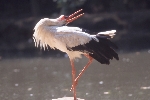
|
| White
stork in bill-clattering (Ciconia ciconia). |
| |
|
| Contrarily
to white stork the black stork doesn't love the
proximity of the man, it frequents woods and
dense forests above all, possibly adjacent to
ponds and swamps.It is distinguished by white one
for the bright black plumage and for the
dimensions slightly reduced (it doesn't normally
overcome 95 cm of height). Suspicious and
solitary, in Italy is still few frequent and
visible, although beginning from 1994 some
sporadic attempts of nest-building have been
observed.
Only the maintenance
of diffused forest environments, under conditions
of good quality, will guarantee in the future the
constant presence of this bird on our territory.
|
| |
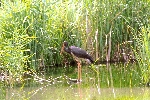
|
Black
stork (Ciconia nigra).
|
| |
|
| We
have a lot of things to do if we want to save
from the extinction these splendid animals, that
a lot of things they have in common with the
human history, and perhaps saving them we do
something of well to ourselves. Personally I believe
that the health of the environment in which we
live reflects it directly on our health.Wish us
therefore to see always the returns of a great
number of storks in our countries and in our
woods,their presence is the litmus paper of a
natural relationship that is reconstructing
between the man and his environment.
|
| |
EUROPEAN
WHITE STORK MIGRATION MAP
|
|
| |
| 1
– ROUT OF GIBRALTAR ( SOUTH –
WEST ) This
rout carries the storks from Holland,
France, Switzerland, West Germany, Spain
end Portugal in Niger, Senegal, Nigeria,
Mali, and Ciad.To reach these states the
storks crosses the Sahara desert without
port .
|
|
| 2
– ROUT OF BOSPHORUS ( SOUTH –
EAST ) The
oriental population coming from East
Germany, Czechoslovakia, Poland,
Hungary,Austria, balcanic peninsula,
Romania and Bulgaria uses this rout,
which after having crossed Turkey, it’s
divided in two branches : the first
branch toward Kenya and Uganda, up to
reach South Africa, the second one toward
Pakistan and western India.
|
|
| 3
– MEDITERRANEAN ROUTE It
is the less used, it crosses the part of
sea that separates Sicily from Africa and
it passes through the strait of Messina.
|
|
| NOTE Migration toward the
African and Asian winter districts begins
in August and September, the return
toward Europe begins in March crossing
the routs in opposite direction. During
these long trips the storks fly to high
altitude using the warm air draughts that
allow them to effect a planed flight (as
a glider).Flying in this manner they are
less tired because they don’t have
to beat the wings in continuation.
|
|
| |
|